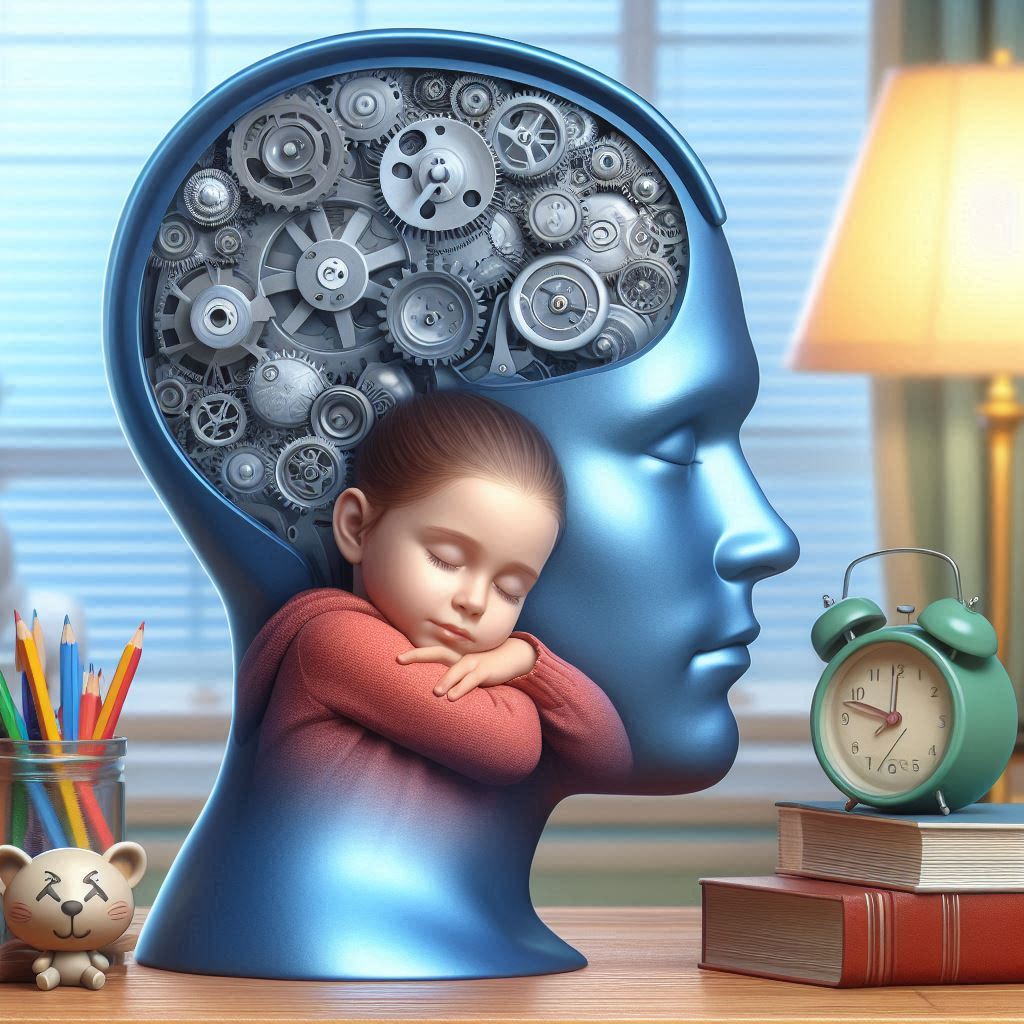Sleep is crucial for children’s physical and mental development. Yet, for many parents, getting their child to sleep quickly can feel like a daily battle. From bedtime tantrums to restless nights, children often struggle with falling asleep for various reasons. However, psychology offers proven techniques to ease the process, based on theories of behavior, habit formation, and relaxation.
In this in-depth article, we will explore multiple psychological methods designed to help children fall asleep faster. These strategies are grounded in well-established psychological theories and have been tested in both research and real-world settings. By understanding and applying these techniques, parents can create an environment conducive to sleep and reduce the struggle associated with bedtime routines.
1. The Importance of a Sleep Routine (Based on Classical Conditioning)
One of the most effective strategies to ensure children fall asleep quickly is establishing a consistent sleep routine. This method is rooted in Classical Conditioning, a theory developed by Ivan Pavlov, which explains how the brain associates certain stimuli with specific responses. Just as Pavlov’s dogs salivated when they heard a bell, children can be conditioned to associate specific routines with falling asleep.
Application:
- Create Predictable Cues: Start by establishing a set of calming pre-bedtime rituals that happen at the same time every night, such as reading a bedtime story, brushing teeth, and turning off the lights. These cues signal the brain that sleep is approaching.
- Consistency is Key: The key to making this work is consistency. Make sure the same steps occur every night in the same order, so the child’s mind begins to anticipate sleep after each cue. Over time, the body will start to relax more quickly at bedtime.

2. Positive Reinforcement (Based on Operant Conditioning)
Operant Conditioning, developed by B.F. Skinner, is a psychological theory that focuses on how behavior can be shaped by reinforcement and punishment. When applied to sleep, this approach can be used to reinforce good sleep habits by rewarding the child when they go to bed on time and fall asleep quickly.
Application:
- Use Rewards for Cooperation: For example, reward the child for staying in bed and falling asleep within a certain amount of time. The reward can be something small, like extra playtime the next day or a sticker that contributes to a larger reward, such as a trip to the park.
- Track Progress: Create a “sleep chart” where the child earns a star each night they go to bed without resistance. After collecting a certain number of stars, they receive a reward.
- Gradual Reinforcement: Initially, offer rewards for smaller accomplishments, such as staying in bed for 10 minutes without calling for a parent. Gradually increase the challenge to reinforce faster sleeping habits.
By consistently rewarding desired sleep behavior, children are more likely to associate bedtime with positive outcomes and less likely to resist.
3. The Role of Environment (Based on the Ecological Systems Theory)
The Ecological Systems Theory by Urie Bronfenbrenner emphasizes the importance of the environment in shaping human behavior. According to this theory, a child’s sleep habits can be influenced by their immediate environment (e.g., the bedroom), family interactions, and broader societal norms.
Application:
- Create a Sleep-Inducing Environment: Ensure that the child’s room is conducive to sleep. Dim lighting, comfortable bedding, a quiet atmosphere, and a stable room temperature are essential components of a calming environment.
- Remove Stimuli: Avoid keeping electronic devices, such as televisions, tablets, or phones, in the child’s room, as the blue light emitted from screens can interfere with the production of melatonin, the hormone responsible for sleep.
- Calming Sounds and Scents: Some parents find success by using white noise machines, calming music, or even diffusing lavender essential oil, which is known for its soothing properties.
By creating an environment that promotes relaxation, children will find it easier to fall asleep and stay asleep throughout the night.
4. Cognitive Behavioral Techniques (Based on Cognitive Behavioral Therapy)
Cognitive Behavioral Therapy (CBT) is a psychological approach that focuses on identifying and changing negative thought patterns and behaviors. When applied to sleep, Cognitive Behavioral Therapy for Insomnia (CBT-I) has been adapted for children, helping them manage anxious thoughts or fears that may be preventing them from falling asleep.
Application:
- Addressing Nighttime Fears: For children who are afraid of the dark or monsters under the bed, CBT techniques can help. Teach the child how to replace scary thoughts with more positive or neutral ones, such as imagining a safe, happy place.
- Relaxation Exercises: Teach the child simple relaxation techniques, such as deep breathing, progressive muscle relaxation, or visualizing calming images. These techniques help reduce the physiological arousal that can keep children awake.
- Journaling Fears: If the child is old enough, keeping a journal of their nighttime fears or worries and then addressing them during the day can help alleviate their concerns before bedtime.
Cognitive techniques like these can help children develop healthier thought patterns around sleep, reducing the likelihood of anxiety-driven sleep disruptions.
5. Sleep Training Techniques (Based on the Ferber Method)
The Ferber Method, developed by Dr. Richard Ferber, is a sleep training technique based on controlled crying. This method is designed to teach children to self-soothe and fall asleep on their own without relying on a parent’s presence.
Application:
- Gradual Check-Ins: Put the child to bed while they are drowsy but still awake. If they start crying or resisting sleep, wait a few minutes before going back to check on them. Gradually increase the time between check-ins each night.
- Self-Soothing: The goal of this method is to teach the child to soothe themselves back to sleep if they wake up during the night. By not immediately responding to every cry, parents help the child develop independence in managing their sleep.
While this method can be challenging for parents due to the crying involved, it has been shown to be effective for many families in the long term.
6. Attachment-Based Approach (Based on Attachment Theory)
Attachment Theory, developed by John Bowlby, emphasizes the bond between a child and their caregiver. Children with secure attachments feel safe and supported, which can significantly impact their ability to fall asleep.
Application:
- Reassurance Before Bed: Spend time providing physical and emotional reassurance before bed. Cuddling, reading a story, or simply talking with the child can help them feel more secure and relaxed.
- Respond to Nighttime Distress: While some sleep training methods suggest waiting before attending to a child’s cries, the attachment-based approach encourages responding promptly to nighttime distress, especially in younger children. This ensures the child knows they can trust their caregiver, reducing anxiety and fostering better sleep.
By prioritizing secure attachment, parents can help their children feel safe and supported, which promotes faster and more peaceful sleep.


7. The Power of Mindfulness and Meditation (Based on Mindfulness-Based Stress Reduction)
Mindfulness, the practice of being present in the moment without judgment, has gained popularity in psychology as a powerful tool for reducing stress and improving well-being. For children, Mindfulness-Based Stress Reduction (MBSR) techniques can help calm the mind and body before sleep.
Application:
- Guided Meditation: Introduce the child to simple guided meditations specifically designed for sleep. These meditations can involve focusing on the breath, imagining a peaceful place, or counting breaths to calm the mind.
- Body Scanning: Teach the child to practice body scanning, where they focus their attention on each part of the body, from head to toe, and consciously relax each muscle. This method helps release tension and prepares the body for sleep.
- Mindfulness Storytime: Instead of reading an exciting or stimulating story before bed, opt for calming mindfulness-based stories that encourage relaxation and introspection.
Mindfulness techniques are particularly effective for children who have difficulty winding down due to overstimulation or anxiety, offering a gentle way to transition into sleep.
Combining Methods for Maximum Effectiveness
While each of these psychological approaches offers unique insights and techniques for helping children fall asleep, the most effective strategy may involve a combination of methods tailored to the individual child. For example:
- Start with a bedtime routine (Classical Conditioning) to create predictability.
- Use positive reinforcement (Operant Conditioning) to reward good sleep behavior.
- Optimize the sleep environment (Ecological Systems Theory) to make the bedroom conducive to sleep.
- Apply cognitive behavioral techniques (CBT) to manage anxiety or fears.
- Incorporate mindfulness exercises for relaxation.
By blending these techniques, parents can address the multiple factors that contribute to sleep difficulties, ensuring a holistic approach to improving their child’s sleep habits.
Improve your skills
Helping a child fall asleep quickly is a challenge that many parents face, but psychology offers a wealth of tools to make the process easier. From creating consistent routines based on classical conditioning to using mindfulness techniques for relaxation, these methods provide practical, evidence-based strategies for improving sleep.
Understanding and applying these psychological principles can transform bedtime from a battle into a peaceful, predictable routine, giving both parents and children the rest they need to thrive.
